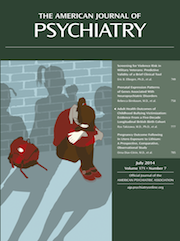Screening for Violence Risk in Military Veterans: Predictive Validity of a Brief Clinical Tool
Abstract
Objective
Violence toward others is a serious problem among a subset of military veterans. The authors evaluated the predictive validity of a brief decision support tool to screen veterans for problems with violence and identify potential candidates for a comprehensive risk assessment.
Method
Data on risk factors at an initial wave and on violent behavior at 1-year follow-up were collected in two independent sampling frames: a national random-sample survey of 1,090 Iraq and Afghanistan veterans and in-depth assessments of 197 dyads of veterans and collateral informants. Risk factors (lacking money for basic needs, combat experience, alcohol misuse, history of violence and arrests, and anger associated with posttraumatic stress disorder) were chosen based on empirical support in published research. Scales measuring these risk factors were examined, and items with the most robust statistical association with outcomes were selected for the screening tool. Regression analyses were used to derive receiver operating characteristic curves of sensitivities and specificities, with area under the curve providing an index of predictive validity.
Results
The resultant 5-item screening tool, called the Violence Screening and Assessment of Needs (VIO-SCAN), yielded area-under-the-curve statistics ranging from 0.74 to 0.78 for the national survey and from 0.74 to 0.80 for the in-depth assessments, depending on level of violence analyzed.
Conclusions
Although the VIO-SCAN does not constitute a comprehensive violence risk assessment and cannot replace fully informed clinical decision making, it is hoped that the screen will provide clinicians with a rapid, systematic method for identifying veterans at higher risk of violence, prioritizing those in need a full clinical workup, structuring review of empirically supported risk factors, and developing plans collaboratively with veterans to reduce risk and increase successful reintegration in the community.



